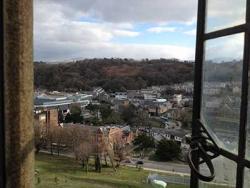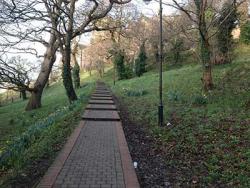Blog - Libraries in the snow: three weeks at the Centre for Arthurian Studies.
 Map from Charles Bertram's Britannicarum Gentium Historiæ Antiquæ Scriptores Tres (1757)In February and March of 2018, I spent three weeks at the at Bangor University, working on , a work containing editions of Gildas and Nennius, and Bertram's forgery of an itinerary by Richard of Cirencester. This is the story of how that went.
Map from Charles Bertram's Britannicarum Gentium Historiæ Antiquæ Scriptores Tres (1757)In February and March of 2018, I spent three weeks at the at Bangor University, working on , a work containing editions of Gildas and Nennius, and Bertram's forgery of an itinerary by Richard of Cirencester. This is the story of how that went.
 View from Centre for Arthurian StudiesOriginally, I had a cunning plan: I would leave Sweden in the throes of late winter weather, and go to Wales, so that in between reading and writing I could enjoy the early spring, with daffodils. This initially worked well: I got a warm welcome from my colleagues at Bangor, and settled in very happily to a routine that would end up producing more text in three weeks than I think I have ever been able to write in such a short time.
View from Centre for Arthurian StudiesOriginally, I had a cunning plan: I would leave Sweden in the throes of late winter weather, and go to Wales, so that in between reading and writing I could enjoy the early spring, with daffodils. This initially worked well: I got a warm welcome from my colleagues at Bangor, and settled in very happily to a routine that would end up producing more text in three weeks than I think I have ever been able to write in such a short time.
Every day, I would arrive on the morning bus - having chosen to stay outside town - and go to the manuscript room to spend the morning working on Bertram's Latin text. Reading and transcribing Latin is, I find, work that requires a fresh mind, not a post-lunch lethargic one. The difficulty with Bertram's text is access to the map he created: to my great joy, a minor administrative fee got me a whole day of photographing it from every conceivable angle. As the map, folded into the book, was very fragile, I preferred to unfold it only once rather than working directly from it every day. The map had a significant impact on 18th and 19th c views on the Roman history of Britain, and is indispensable for any serious study of Bertram's work.
In the afternoon, I would go up to the Centre high up in the tower, open the window to the spectacular view over Bangor, and guiltily browse the shelves for a bit before settling down to work. Even though the Flintshire Harries Arthurian Collection proved to be a temptation to take breaks, I would loop my laptop cord over the sword in the stone prop, and then I would write.
 College Park, Bangor UniversityIt turns out that the library, in addition to possessing a copy of Britannicarum Gentium Historiæ Antiquæ Scriptores Tres, provides access to digitalised 18th and 19th century magazines such as The Gentleman's Magazine, The Antiquary, and British Critic, which enabled me to track the whole discussion of Bertram's text for the first hundred years after its publication. I accessed over fifty texts, from long discussions of the text's qualities and veracity to brief letters to the editor, and this made it possible to finish my chapter on the reception of Bertram's work. During the weeks at the Centre I ended up writing 20, 000 words. I also got started on a paper on Bertram's two editions of Nennius, which I read at the Centre's symposium "Arthurian Legends in Wales and Beyond," in June. In between writing bouts, I had opportunities to discuss my work with knowledgeable colleagues over tea. All in all, my stay at the Centre for Arthurian Studies supported my work to an extent I find it hard to believe I could have got elsewhere.
College Park, Bangor UniversityIt turns out that the library, in addition to possessing a copy of Britannicarum Gentium Historiæ Antiquæ Scriptores Tres, provides access to digitalised 18th and 19th century magazines such as The Gentleman's Magazine, The Antiquary, and British Critic, which enabled me to track the whole discussion of Bertram's text for the first hundred years after its publication. I accessed over fifty texts, from long discussions of the text's qualities and veracity to brief letters to the editor, and this made it possible to finish my chapter on the reception of Bertram's work. During the weeks at the Centre I ended up writing 20, 000 words. I also got started on a paper on Bertram's two editions of Nennius, which I read at the Centre's symposium "Arthurian Legends in Wales and Beyond," in June. In between writing bouts, I had opportunities to discuss my work with knowledgeable colleagues over tea. All in all, my stay at the Centre for Arthurian Studies supported my work to an extent I find it hard to believe I could have got elsewhere.
Of course, the rest of my cunning plan did not work out so well. A few days into my stay we had unexpected snow, with no water at my airbnb, and the daffodils entirely under the weather, so to speak. Once I got home, I discovered that this was one of those years that the Swedish winter decides to last into April, and that climbing over a mountain of snow to get to my front door might be something I'm getting a little too old for. Nevertheless, I brought with me new insights, a finished chapter, and the pleasure of interacting with colleagues in my own field. Surely scholars have endured more for less.
Dr. Kristina Hildebrand, Halmstad University
Publication date: 7 February 2019
